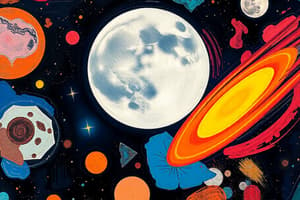Podcast
Questions and Answers
What is the primary characteristic that defines a planet?
What is the primary characteristic that defines a planet?
- It produces its own energy.
- It is a celestial body that is visible to the naked eye.
- It has a rocky composition.
- It orbits around a star. (correct)
Which ancient Greek philosopher is credited with proposing a heliocentric model of the universe?
Which ancient Greek philosopher is credited with proposing a heliocentric model of the universe?
- Ptolemy
- Aristotle
- Copernicus (correct)
- Pythagoras
What is the primary reason why celestial bodies appear to rotate around the Earth before the invention of the telescope?
What is the primary reason why celestial bodies appear to rotate around the Earth before the invention of the telescope?
- Due to the Earth's orbit around the Sun.
- Due to the Earth's rotation.
- Due to the frame of reference. (correct)
- Due to the gravitational pull of the Moon.
What is the characteristic of the orbits of celestial bodies in a heliocentric model of the universe?
What is the characteristic of the orbits of celestial bodies in a heliocentric model of the universe?
Which planet in our solar system has the largest atmosphere?
Which planet in our solar system has the largest atmosphere?
What is the primary characteristic of a nebula?
What is the primary characteristic of a nebula?
What is the term for the group of stars that form patterns in the night sky?
What is the term for the group of stars that form patterns in the night sky?
Which planet in our solar system has the most moons?
Which planet in our solar system has the most moons?
What is the primary force that holds a galaxy together?
What is the primary force that holds a galaxy together?
What is the term for the process by which stars are created?
What is the term for the process by which stars are created?
Flashcards are hidden until you start studying
Study Notes
Observations before the Telescope
- Herds migrate with the seasons, and plants produce berries and seeds at specific times of the year.
- The moon's shape appears to remain constant over 28 days.
- The sun rises in one direction and sets in the other.
- Stars rise approximately 4 minutes earlier each night.
- The moon has phases and rises and sets at different times than the sun and stars.
- Observations revealed a variety of celestial bodies, with stars staying in the same positions relative to each other, forming patterns called constellations.
Celestial Bodies and Ancient Views
- Celestial bodies refer to objects in space.
- A constellation is a group of stars.
- Wanderers (planets) are celestial bodies that rise and set at different times.
- Planets do not produce their own energy and travel in orbit around a star.
- Indigenous views were governed by interconnection to nature, ancestor spirits, and the creators, with knowledge shared through natural phenomena, including stars.
Geocentric and Heliocentric Models
- Geocentric model: an earth-centered universe (incorrect).
- Aristotelian view: Earth at the center, with planets and stars attached to transparent spheres orbiting the Earth.
- Ptolemaic view: planets orbit on epicycles to explain retrograde motion and changing brightness.
- Heliocentric model: a sun-centered universe (correct).
- Key figures: Copernicus, Galileo, Kepler, Newton, and Einstein.
Our Solar System
- The solar system includes eight planets that orbit the sun.
- Inner (Terrestrial) planets: Mercury, Venus, Earth, and Mars.
- Outer (Jovian) planets: Jupiter, Saturn, Uranus, and Neptune.
- The sun is 100 times larger than the Earth, comprising 99.8% of the solar system's mass.
Planets
- Mercury: closest planet, one day is 176 Earth days, one year is 88 days, small atmosphere, large temperature range, rocky.
- Venus: hottest planet, one day is 243 Earth days, one year is 225 Earth days, large atmosphere, rocky.
- Earth: one moon, rocky.
- Mars: days are just longer than one Earth day, one year is 687 Earth days, average temperature is -60°C, rocky.
- Jupiter: gas giant, 75 moons, Jovian, gaseous.
- Saturn: gas giant, large ring, Jovian, one day is just under 11 hours long, one year is 29 Earth years.
- Uranus: four times the diameter of the Earth, 17 hours in one day, 84 Earth years, gaseous, Jovian.
- Neptune: one day is 16 hours long, one year is 165 Earth years, gaseous, Jovian.
Beyond Our Solar System
- Nebula: an interstellar cloud of gas and dust created by the formation and destruction of stars.
- Galaxy: a system of stars, dust, celestial bodies, and stars held together by gravity.
- Stars: burning balls of gas created by nuclear fusion when a dense cloud of gas and matter collide.
Studying That Suits You
Use AI to generate personalized quizzes and flashcards to suit your learning preferences.




